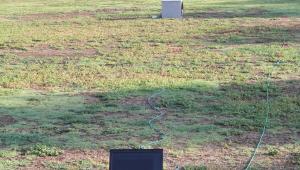The Schroeder Frequency: A Show and Tell, Part 1

To midrange and treble frequencies, your listening room is like a billiards table. Like billiard balls, mid- and high-frequency sounds tend to bounce all around your room, until they run out of energy. Because of this frenetic reflection, midrange and treble frequencies spread pretty evenly — or diffuse — throughout a room.
To bass frequencies, your listening room is like a beer bottle when you blow across its top. In other words, it’s a resonator. Sounds whose wavelengths match the dimensions of the room will resonate — in other words, they’ll be amplified. Sounds whose wavelengths don’t match the dimensions aren’t amplified. Depending on where your speaker is placed in the room, and where you are placed in the room, some of the bass sound waves will reinforce each other, while others cancel each other out. Move to a different spot in the room and different frequencies may be reinforced or canceled.
Schroeder’s sound science
The scientist who first noted a room’s split acoustical personality (if you will) was a German physicist named Dr. Manfred Schroeder. (Not to be confused with Schrödinger, the dude who discovered that a cat explodes if you put it in the microwave.) Back in 1954, Schroeder referred to the frequency at which rooms go from being resonators to being reflectors/diffusors as the “crossover frequency.” We now call it the Schroeder frequency.
It’s easy to confirm Schroeder’s discovery. First play a bass tone through your speaker system. Walk around the room and you’ll hear the level of the tone change radically from place to place. Now play a midrange tone and walk around the room. It might be slightly quieter in some places, slightly louder in others, but you won’t hear a big difference.
In a typical residential listening environment, the Schroeder frequency falls between 100 and 200 Hz. You can calculate it by dividing your room’s reverberation time in seconds by the volume of your room in cubic meters, then multiplying the square root of that sum by 2000.
Don’t have the reverberation time of your room handy? Well, you can measure your room’s approximate Schroeder frequency if you have a real-time analyzer application such as True RTA that lets you display several different frequency response measurements at once. You’ll need a measurement microphone (anything will do) and a USB interface with phantom power.
First, connect the audio output of your USB interface to either the left or right channel of an unused audio input of your sound system. Place the measurement mike anywhere in the room, making sure that it has a clear line-of-sight to the speaker. Play some pink noise from True RTA’s generator and note the average sound pressure level (SPL) using True RTA’s built-in meter. Now hit the Quick Sweep and run a frequency response sweep through your audio system.
Store that result, then move the mike to a different place in the room. Play the pink noise again, adjust True RTA’s output level so that the average SPL roughly matches the SPL of the first measurement, then run another Quick Sweep. It doesn’t matter where in the room you make the measurements, just try to get a variety of positions and make sure there’s nothing standing between the mike and the speaker. Repeat the process three or four times.
You can see the results from my listening room in Figure 1. See how above about 200 Hz, the measurements all look roughly the same? Those sounds are above the Schroeder frequency. Now see how below 200 Hz, the response varies from position to position? These sounds are below the Schroeder frequency. Thus, my room’s Schroeder frequency is about 200 Hz (or maybe even a little higher).
Don’t want to bother with all this measurement stuff? OK, figure your room’s Schroeder frequency is 200 Hz. Close enough.
Make sure to check out part 2 of this article. We’ll discuss the implications of the Schroeder frequency for your listening room — and how you can best optimize your system to deal with this immutable law of physics.
- Log in or register to post comments




































































